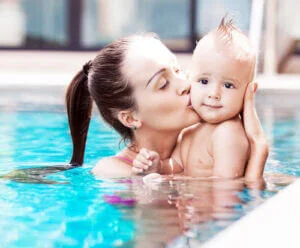Role Model or Control Freak?
Originally written for BonBonBreak in May, 2016.
Last updated October 2024
They were there to learn how to swim. “Are you nervous or do you have pain?” The young mom over-enunciated the words with a look of grave concern as she spoke to Emily, her two-year-old daughter. She repeated it over and over. “Are you N-E-R-V-O-U-S or do you have P-A-I-N?” I tried to stay focused as I counted and gently poured warm water over each child’s head. They would blink their eyes, then look at their parents to see how they should react. “Good job,” everyone would smile. “Yay!” We all clapped. The once unnerving activity soon became a fun game that parent and child played together, counting and pouring water over each other’s heads. It was a perfect introduction to water safety and creating a healthy relationship with water.
The laughter was contagious, but it was difficult to ignore the uncomfortable interaction occurring in the midst of the fun. “N-E-R-V-O-U-S or P-A-I-N?” As mom repeated the question, Emily stared right at her and yelled louder. Nervous or pain. Those were the only two options a two-year-old had to choose from during my super awesome swimming lesson. I was shocked. I calmly advised the distraught mother to relax – it was just water. I motioned for mom to pour water over her own head to show Emily that it was okay. She glared at me and held her daughter tightly.
I’m not sure why Emily’s mom was ‘protecting’ her from water, but I see this behavior all the time. When discussing swimming with your child, I implore you to use positive language. Statements such as, “Don’t be scared,” or “There’s nothing to be afraid of” are like fingernails on a chalkboard for swim teachers. Kids hear scared and afraid and become just that. When you project your fears and insecurities onto your child or use negative language, you are sending a message that, in this case, could be fatal.
Swimming is not an optional activity and should not be taken lightly. Please don’t tell me: “My son didn’t want to come today, but I told him he has to because if he doesn’t learn, he’ll drown. I promised that he won’t get his face wet and he can just play on the steps.” Seriously? You have just made yourself a liar and set your son up for failure because you have hired me to teach him swimming, a lifesaving skill that requires getting his face wet. It’s just water.
Your kids listen, even when you think they don’t. They watch you. You know that, right? They look to you to see how you act in a situation. If you are afraid of the pool, they will be afraid. If you put your hands up to protect your face from water, you’re showing that getting your face wet isn’t okay. If you are uncomfortable, your child will be uncomfortable. So, if you value water safety and learning how to swim, your child will do the same.
In my last blog post When Mom Doesn’t Know How to Swim, I asked you to think about your relationship with the water. I love hearing everyone’s unique story. I get e-mails from adults that use words like ‘shame,’ ‘humiliating’ and ‘paralyzing fear’ to describe their swimming experience. Hearing this breaks my heart, yet inspires me. Working with these terrified non-swimmers happens to be my super power! When I am mindful and completely focused, I can bring a student (of any age or ability) to a level in the water they never imagined was possible. In just one 90 minute Breakthrough Session, fearful non-swimmers are transformed into confident, hopeful individuals with a healthy respect for water. It’s an incredible experience.
Are you comfortable putting your face in the water? If not, I encourage you to try. If you are comfortable, share your story as an inspiration to others. Nobody is ever drown-proof, water-safe or done learning in the water. Swimming shouldn’t be a two-week set of swimming lessons once every summer. It is an essential, lifelong, lifesaving skill. Empowering yourself with a healthy aquatic relationship will enhance the quality of your life, as well as the lives of your entire family.
If you’re not comfortable in the water, you’re definitely not alone. According to the CDC, 37% of American adults can’t swim the length of a pool. If you are one of them, now is the time to do something about it. Be an example. Set an example. Take lessons. It’s never too late.
So embrace the influential role model you are and be an example for your loved ones. Tell your story.
Put your face in the water.






